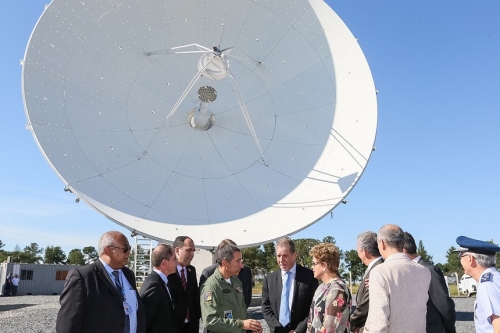Argentina, Brazil, Mexico, Colombia and Peru are just a few of those that are pushing broadband universalization programs which also rely on satellites to connect remote and rural areas.
Besides, nanosatellites, airlines and ship connections and the expected operation of a new space launch base in Brazil, make the region a hotspot for the segment.
Below follow the key developments in the market.
ARGENTINA’s ARSAT
The Fernández administration plans to launch a third satellite under the geostationary Arsat program to help universalize internet in the country. The idea is to have the satellite in orbit by 2023.
Argentine state-run network operator Arsat, in charge of the geostationary program, and state technology research body Invap, already held a first working meeting. Suppliers and other partners still need to be found.
The two satellites, Arsat 1 and Arsat 2, were put into orbit through the Ariane-5 launcher from Arianespace, in October 2014 and September 2015, respectively.
"Arsat 1 and 2 satellites have sold almost all their internet services, so it was necessary to build another one: Arsat Second Generation 1 (SG1), which will increase capacity and provide connectivity to the entire Argentine territory at a reasonable cost," Gabriel Cristian Absi, Invap space area manager told state news agency Télam.
Arsat's two satellites use Ku-band and C-band, more appropriate for TV broadcasting than internet connectivity, and Arsat 1's coverage extends to Canada, while Arsat 2 covers national territory and immediate neighbors.
Plans for the new satellite remained dormant during the previous Macri administration.
In an interview with BNamericas in 2018, former Arsat CEO Rodrigo de Loredo estimated that Arsat 3 would require investments of up to US$250mn. Hughes was among the partners under consideration at the time.
ALCÂNTARA AND MICRO/NANOSATELLITES
One other segment with a lot of potential in the region, especially for research purposes due to its low cost, relates to micro and nanosatellites.
With senate approval of the Brazil-US Alcântara launch base deal, Brazil could start commercializing the pad for space launches in the next two years once the settlement consultations and negotiations with the local Alcântara community conclude.
The Alcântara center will be used mainly for the launches of small-scale satellites while Brazil's space agency (AEB) confirmed foreign companies have signaled interest in this type of launch.
The AEB is equally focusing on mid-sized satellites for environmental and climate monitoring and plans to launch the Amazonia-1 satellite in the second half.
Alcântara is considered a prime spot for space launches due to its proximity to the Equator line, which is said to reduce fuel costs for take-offs by up to 30%.
Brazil estimates that the commercial use of the Alcântara Space Center (CEA) has the potential to generate annual revenues of at least US$3.5bn in the short term and US$10bn by 2040.
Mexico, too, has adopted a focus on nanosatellite.
Recently, the country launched AztechSat-1, its first nanosatellite. The equipment went on board a SpaceX rocket as part of the supply mission of International Space Station CRS-19.
The project has its origin in a collaboration agreement between AEM and Nasa, which provided technical support and paid for the launch to the ISS, but the mission is also a technological test to validate the possibility of communication between AztechSat-1 and the constellation of GlobalStar communications satellites.
Mexico also plans to conclude by the end of March a tender of 1,200 satellite-based internet access points for the connection of remote educational, health and social welfare sites as part of the Internet para Todos and the Public Sites Connectivity programs
The transport and telecoms ministry is currently inviting companies to bid.
According to Research and Markets, the global nanosatellite and microsatellite market is set to hit US$3.6bn by 2024, up from US$1.5bn in 2019, for CAGR of 19.8% in the period.
AIRLINES, MARITIME AND MORE
Demands for connectivity on board of ships and planes also represent good opportunities for the industry, on which companies like SES, Intelsat and Hispasat are betting.
Intelsat recently selected Maxar Technologies to manufacture its Intelsat 40e, a next-generation geostationary communications satellite scheduled to launch in 2022.
The satellite will serve customers in North and Central America, including commercial and private planes. It is also aimed at connecting vehicles on land and other mobility applications.
Likewise, Thales Alenia Space will build a satellite for Spanish satellite telecommunications operator Hispasat, Amazon Nexus, whose coverage area will include Latin America and the air and maritime segments.
Amazon Nexus is the third satellite Hispasat ordered from Thales.
For Luxembourg-based SES, a prime bet has been on the middle-earth-orbit (MEO) constellations, although the company is also eyeing the low-orbit-earth (LEO) ones.
Both are booming and are seen as key especially for military and mission-critical communications, due their low latency.
EASE IN REGULATION
A welcoming point in some markets across the region has been the flexibilization of rules and the reduction of costs associated with satellite equipment and orbital licensing.
Brazil's regulator Anatel, for example, has approved an update of the rules for the licensing telecommunications stations to reduce the administrative burden and support the expansion of services.
This is expected to support the use of wireless frequencies in remote areas to serve industries such as agriculture and mining. Interested companies will have to request authorization and inform the regulator of the territorial limits of the operation.
In addition, the new regulation changes the procedure used by Anatel to authorize orbital positions for satellites.
Anatel is also moving to cut taxes for on-the-ground Vsat antennas, something seen as key to US firm Viasat, which provides terrestrial network equipment and satellite services to connect to Brazil’s SGDC-1 satellite.
Telebras is the owner and manager of SGDC-1, the Brazilian geostationary satellite for defense and communications, whose civil capacity was awarded to Viasat as part of the Gesac broadband connectivity program.
But Viasat is also working on the deployment of community Wi-Fi infrastructure in isolated regions in Brazil, having picked Ruralweb as partner.
In Mexico, this community Wi-Fi program is being conducted in partnership with Facebook.
Viasat equally works in the in-flight market with airlines such as Aeromexico and Brazil’s Azul.
DTH
On the downside, the base of satellite pay TV subscribers continues to decline across Latin America amid adverse economic conditions and competition with OTT.
The Brazilian pay TV market ended 2019 with 15.7mn clients, down nearly 10% and going back to 2012 levels.
Of total accesses, Direct-to-Home accounted for 51% and cable TV for 43.3%.
https://www.bnamericas.com/en/features/latam-satellite-market-what-to-look-for-in-2020
 Operations Committee
Operations Committee
